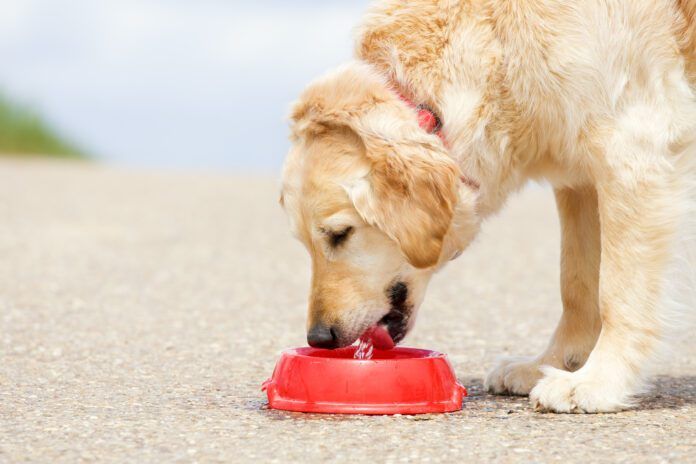A dog will start to show signs of dehydration after 24 hours without water. Dehydration occurs when a dog loses body fluids faster than he can replace them. It involves a loss of water and electrolytes, whether due to illness (especially vomiting and/or diarrhea) or inadequate fluid intake.
Dehydration can cause a dog to dry vomit and/or have diarrhea, both of which increase the dog’s dehydration. A dehydrated state affects your dog’s circulation, which means when the dog is dehydrated the heart must work harder and the brain may not get enough oxygen and nutrients. Severely dehydrated dogs who have gone too long without water can go into shock and die. Dehydration can quickly become a medical emergency.
Signs of Dehydration in Dogs
A dry mouth, dry nose, and excessive panting with thick saliva instead of liquid drool are mild signs of dehydration but a huge warning that your dog has gone too long without water and needs immediate access to clean, fresh water.
Symptoms your dog is dehydrated may include:
- Loss of skin elasticity (skin doesn’t immediately spring back into place when lifted up)
- Dry mouth (gums appear dry and tacky instead of moist and shiny)
- Thick saliva (not clear)
- Sunken eyes (in advanced cases)
- Signs of shock, such as collapse (in advanced cases)
The serious signs of dehydration appear quickly. His eyes look sunken. His skin will “tent up” if you pinch a bit (gently) by his shoulders. Normally, that skin should snap back into place. These warnings mean internal problems are starting to reflect the poor hydration. A dog who has gone too long without water may need veterinary attention. The effects of dehydration can harm your dog.
If you suspect your dog is dehydrated, get to the veterinarian or an emergency veterinary clinic immediately. Call the clinic to let them know you’re coming in with an emergency. You can offer water and/or an electrolyte solution such as Pedialyte on your way. One study found that dogs were more likely to increase fluid consumption if provided a flavored electrolyte solution, like Pedialyte. Keep your dog cool in the car with the AC on or a fan blowing on him.
How Long Can Dogs Go Without Water?
Dogs should have constant access to water, 24 hours a day. While the maximum time a dog can go without water is 48 to 72 hours, that’s for a healthy adult dog. Dogs with special needs, like puppies, seniors, and sick dogs, cannot go that long.
Prevent Dehydration in Dogs
Make sure your dog has access to fresh, clean water. If he’s in a crate or ex-pen while you’re out of the house, be sure you’ve left him with water. If you will be away for hours, consider freezing a bowl of water so it will slowly melt. That way, spillage is reduced, and there is renewable, cold, clean water for your dog to drink.
Your dog should have fresh water available all the time (learn how much water your dog needs to drink), and it should be changed at least daily. Water is essential for many bodily functions, including making urine to remove toxic metabolic wastes. Water helps your dog to thermoregulate when he is hot by panting. Blood flow, nerve and muscle function, and electrolyte balance are all affected by hydration. No dog should ever go without water long enough to enter a state of dehydration.






